Crossref Citations
This article has been cited by the following publications. This list is generated based on data provided by
Crossref.
Clarke, Adele E.
2008.
Introduction: Gender and Reproductive Technologies in East Asia.
East Asian Science, Technology and Society: An International Journal,
Vol. 2,
Issue. 3,
p.
303.
Prainsack, Barbara
and
Gmeiner, Robert
2008.
Clean Soil and Common Ground: The Biopolitics of Human Embryonic Stem Cell Research in Austria.
Science as Culture,
Vol. 17,
Issue. 4,
p.
377.
Clarke, Adele E.
2008.
Introduction: Gender and Reproductive Technologies in East Asia.
East Asian Science, Technology and Society: An International Journal,
Vol. 2,
Issue. 3,
p.
303.
Prainsack, Barbara
2011.
Overcoming embryonic exceptionalism? Lessons from analyzing human stem cell research regulation in Israel.
New Genetics and Society,
Vol. 30,
Issue. 3,
p.
267.
Kulawik, Teresa
2012.
Exploring Central and Eastern Europe’s Biotechnology Landscape.
Vol. 9,
Issue. ,
p.
55.
Mintrom, Michael
2013.
Policy entrepreneurs and controversial science: governing human embryonic stem cell research.
Journal of European Public Policy,
Vol. 20,
Issue. 3,
p.
442.
Beltrame, Lorenzo
2013.
Disputing the boundary of pluripotency. The Italian public debate on amniotic fluid-derived stem cells.
New Genetics and Society,
Vol. 32,
Issue. 4,
p.
385.
Prainsack, Barbara
and
Wahlberg, Ayo
2013.
Situated bio-regulation: Ethnographic sensibility at the interface of STS, policy studies and the social studies of medicine.
BioSocieties,
Vol. 8,
Issue. 3,
p.
336.
Haddad, Christian
Chen, Haidan
and
Gottweis, Herbert
2013.
The Global Dynamics of Regenerative Medicine.
p.
88.
Kim, Sang-Hyun
2014.
The Politics of Human Embryonic Stem Cell Research in South Korea: Contesting National Sociotechnical Imaginaries.
Science as Culture,
Vol. 23,
Issue. 3,
p.
293.
Beltrame, Lorenzo
2014.
The Therapeutic Promise of Pluripotency and its Political use in the Italian Stem Cell Debate.
Science as Culture,
Vol. 23,
Issue. 4,
p.
493.
Korolczuk, Elżbieta
2016.
‘The purest citizens’ and ‘IVF children’. Reproductive citizenship in contemporary Poland.
Reproductive Biomedicine & Society Online,
Vol. 3,
Issue. ,
p.
126.
Parfenchyk, Volha
2016.
Redrawing the boundary of medical expertise: medically assisted reproduction and the debate on Italian bioconstitutionalism.
New Genetics and Society,
Vol. 35,
Issue. 4,
p.
329.
Meskus, Mianna
2018.
Craft in Biomedical Research.
p.
1.
Okada, Ellie
2019.
Management of Knowledge-Intensive Organizations.
p.
99.
Parfenchyk, Volha
2020.
Embryo as ‘one of us’: Assisted reproductive technologies and the making of ‘homo juridicus’ in Italy.
BioSocieties,
Vol. 15,
Issue. 1,
p.
46.
Metzler, Ingrid
and
Pichelstorfer, Anna
2020.
Religion and Biopolitics.
p.
73.
Weiberg-Salzmann, Mirjam
and
Passerini, Massimiliano
2020.
Religion and Biopolitics.
p.
225.
Durnová, Anna
Schmid, Julia
and
Herzog, Sylvia
2024.
(Un)Eingeschränkte Selbstbestimmung? Gesellschaftliche Reproduktionsdiskurse als Regulativ von Körper, Wissen und Emotionen.
Österreichische Zeitschrift für Soziologie,
Vol. 49,
Issue. 3,
p.
417.


